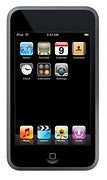Nokia is developing a device to link mobile phones to home automation systems. Using a mobile phone consumers will be able monitor and control security, heating, and ventilation systems via its gateway Home Control Center, Nokia announced on Thursday.

With appropriate equipment, users will be able to see who is ringing the doorbell at home, via the mobile phone. They can then talk to the person, and for example open the door to a handyman, according to Nokia.
Nokia's first systems are expected to become commercially available by the end of 2009, said Toni Sormunen, director for the Smart Home Program at Nokia.
The heart of the Nokia system is the Home Control Center (HCC), a piece of hardware which will act as gateway between different systems for home automation and the mobile phone, or any device that is equipped with a browser.
Phones will talk to the HCC via an Internet connection or Wi-Fi. Nokia has developed a native client for phones running its Symbian S60 software, and a browser-based client for other devices.
Using the native client users will be able to plug the phone into the HCC with a USB cable, and everything is installed automatically. The native client will also be more responsive, and users won't have to log in when they access their HCC, according to Kari Rantanen, director of sales and marketing at Nokia's Smart Home Program.
The HCC will then be able to talk to security, heating, and ventilation systems via home automation systems. Nokia will initially support only one, Z-Wave, but is opening up its system to enable partners to implement support for other home automation technologies such as ZigBee or KNX (Konnex).
It chose to start with Z-Wave because the number of available products. The members of the Z-Wave Alliance have already introduced 300 products to the market, according to Sormunen.
It will also be up to third parties to integrate different solutions with the HCC, using an SDK (Software Development Kit), which at this point is only available to selected partners under a non-disclosure agreement, according to Rantanen.
"Partnering is very important. We understand our limitations; we are good at creating communication technologies, embedded devices and software platforms," said Sormunen.
Nokia is currently working with German energy company RWE to distribute the system. Their first joint product will focus on home heating management, and be sold by RWE to its customers by the end of next year.
The system will consist of a central control unit together with remote-controlled thermostats for radiators. The user interface will be the PC and the mobile phone. In addition, a separate display will be available, according to Nokia.
Nokia is also working with a number of other companies, including Zen-sys, the inventor and manufacturer of chips for Z-Wave, and Delta Dore, which develops energy management, safety and control systems.
"This is an interesting market," said Sormunen. "There is a consumer interest and need, and the technology is maturing." Equipment prices are coming down as the technology becomes more common -- but success won't come overnight; it is still a few years away, said Sormunen.
The Finnish phone giant is far from the only company that wants to be the center of home automation systems.
"Nokia have been quick on its feet, but there are other companies who are doing similar things," said Johan Stråkander, marketing manager at Swedish company Manodo, which has developed a home automation gateway of its own.
But Nokia entering the market is giving it stamp of approval, according to Stråkander.
SOURCE:pcworld.com












